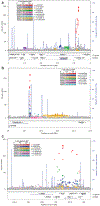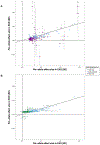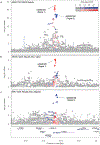Identification of type 2 diabetes loci in 433,540 East Asian individuals
- PMID: 32499647
- PMCID: PMC7292783
- DOI: 10.1038/s41586-020-2263-3
Identification of type 2 diabetes loci in 433,540 East Asian individuals
Abstract
Meta-analyses of genome-wide association studies (GWAS) have identified more than 240 loci that are associated with type 2 diabetes (T2D)1,2; however, most of these loci have been identified in analyses of individuals with European ancestry. Here, to examine T2D risk in East Asian individuals, we carried out a meta-analysis of GWAS data from 77,418 individuals with T2D and 356,122 healthy control individuals. In the main analysis, we identified 301 distinct association signals at 183 loci, and across T2D association models with and without consideration of body mass index and sex, we identified 61 loci that are newly implicated in predisposition to T2D. Common variants associated with T2D in both East Asian and European populations exhibited strongly correlated effect sizes. Previously undescribed associations include signals in or near GDAP1, PTF1A, SIX3, ALDH2, a microRNA cluster, and genes that affect the differentiation of muscle and adipose cells3. At another locus, expression quantitative trait loci at two overlapping T2D signals affect two genes-NKX6-3 and ANK1-in different tissues4-6. Association studies in diverse populations identify additional loci and elucidate disease-associated genes, biology, and pathways.
Conflict of interest statement
COMPETING INTERESTS
The authors declare no competing interest.
Figures












References
Publication types
MeSH terms
Substances
Grants and funding
- N01 HC095161/HL/NHLBI NIH HHS/United States
- N01 HC095168/HL/NHLBI NIH HHS/United States
- 212946/Z/18/Z/WT_/Wellcome Trust/United Kingdom
- R01 DK072193/DK/NIDDK NIH HHS/United States
- R01 CA124558/CA/NCI NIH HHS/United States
- MC_UU_00017/1/MRC_/Medical Research Council/United Kingdom
- R01 HL085144/HL/NHLBI NIH HHS/United States
- R01 DK078150/DK/NIDDK NIH HHS/United States
- R01 DK093757/DK/NIDDK NIH HHS/United States
- R01 DK080720/DK/NIDDK NIH HHS/United States
- MC_U137686851/MRC_/Medical Research Council/United Kingdom
- UL1 TR001079/TR/NCATS NIH HHS/United States
- N01 HC095169/HL/NHLBI NIH HHS/United States
- R01 HD030880/HD/NICHD NIH HHS/United States
- U01 DK105556/DK/NIDDK NIH HHS/United States
- R01 CA144034/CA/NCI NIH HHS/United States
- R01 HL142302/HL/NHLBI NIH HHS/United States
- R01 DK104371/DK/NIDDK NIH HHS/United States
- MC_UU_12026/2/MRC_/Medical Research Council/United Kingdom
- N01 HC095167/HL/NHLBI NIH HHS/United States
- P20 RR020649/RR/NCRR NIH HHS/United States
- R01 TW005596/TW/FIC NIH HHS/United States
- R01 DK062370/DK/NIDDK NIH HHS/United States
- U01 DK105535/DK/NIDDK NIH HHS/United States
- R01 HL108427/HL/NHLBI NIH HHS/United States
- U01 CA182876/CA/NCI NIH HHS/United States
- P30 DK063491/DK/NIDDK NIH HHS/United States
- R01 CA064277/CA/NCI NIH HHS/United States
- R01 DK066358/DK/NIDDK NIH HHS/United States
- MC_PC_14135/MRC_/Medical Research Council/United Kingdom
- UL1 TR001420/TR/NCATS NIH HHS/United States
- D43 TW009077/TW/FIC NIH HHS/United States
- U01 DK062370/DK/NIDDK NIH HHS/United States
- U01 DK105554/DK/NIDDK NIH HHS/United States
- T32 GM007092/GM/NIGMS NIH HHS/United States
- T32 HL069768/HL/NHLBI NIH HHS/United States
- P30 DK056350/DK/NIDDK NIH HHS/United States
- P30 DK020572/DK/NIDDK NIH HHS/United States
- R01 TW008288/TW/FIC NIH HHS/United States
- UL1 TR000040/TR/NCATS NIH HHS/United States
- RF1 AG061351/AG/NIA NIH HHS/United States
- N01 HC095166/HL/NHLBI NIH HHS/United States
- N01 HC095162/HL/NHLBI NIH HHS/United States
- U01 DK105561/DK/NIDDK NIH HHS/United States
- UL1 TR001881/TR/NCATS NIH HHS/United States
- 200837/Z/16/Z/WT_/Wellcome Trust/United Kingdom
- UM1 CA182910/CA/NCI NIH HHS/United States
- N01 HC095164/HL/NHLBI NIH HHS/United States
- R01 TW006207/TW/FIC NIH HHS/United States
- N01 HC095165/HL/NHLBI NIH HHS/United States
- MC_PC_13049/MRC_/Medical Research Council/United Kingdom
- UL1 TR003098/TR/NCATS NIH HHS/United States
- UM1 CA182876/CA/NCI NIH HHS/United States
- N01 HC095160/HL/NHLBI NIH HHS/United States
LinkOut - more resources
Full Text Sources
Medical
Miscellaneous

